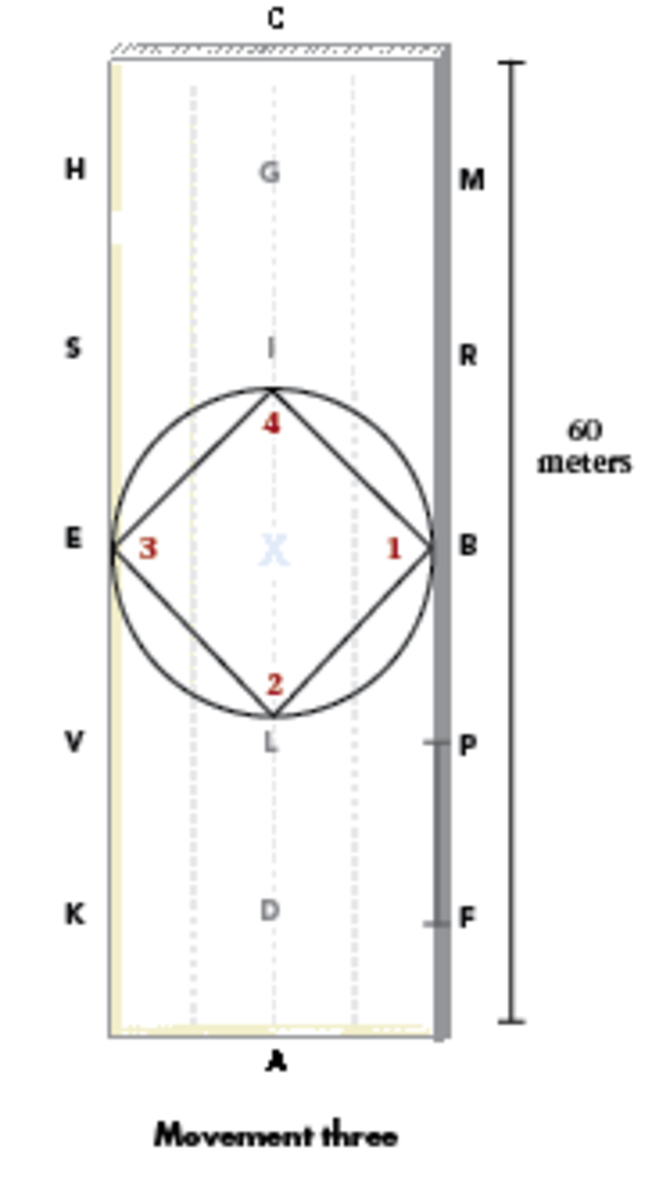Now that we have reviewed the geometry of the dressage arena (January issue) and some great foundation exercises in the months following, you are ready to apply what you have learned to the USDF Introductory Level, Test C. Even if you are not interested in riding Introductory Level in a competition, it is a wonderful test to memorize and master. This test will challenge you to practice and improve foundation movements like the centerline, transitions and circles that you will need throughout your dressage career. Additionally, knowing this test by heart is a great go-to warm-up at home or shows when you need a structured plan to test that your horse is responsive and ready in all three gaits.

Let us begin with movement one: A, enter working trot rising. X, halt through medium walk. Salute, proceed working trot rising.
As you turn up centerline at A, recall how we rode the three-loop serpentines (February) by riding a half-circle and then straightening. Though you are not riding a serpentine, the “half-circle then straighten” necessary for a correct serpentine has prepared you to ride a bending line around the exterior corner of the arena before A and turn up centerline with stick-straight accuracy.
Additionally, you are prepared for the halt through medium walk, salute, proceed working trot rising thanks to the quick transitions you learned in April. Remember to take your time. You don’t have to hit the brakes like you are about to fall off a cliff. Halt through medium walk, take a deep breath and relax in your salute and then collect yourself before proceeding in working trot through a few steps of walk. Though the halt, salute may be new, you and your horse are up to the task now that you have added so many transitions to your training.
Movement two: Track right at C in working trot rising. Again, ride the turn onto the track as you would the serpentine, only this time go from a straight line into a bending line.
Movement three: B, circle right 20 meters (see diagram). Aren’t you glad you know the four points you need to hit on a 20-meter circle (January)? Remember to ride more of a diamond shape if your horse starts to make the circles too large/square, as we discussed last month.
Movement four, five and six: A, circle right 20 meters developing working canter in first quarter of the circle, right lead. Before A, working trot rising. A combination of riding a diamond and remembering your quick transitions will be the keys to success. It is no coincidence that the transitions are scored seperately to check that you have enough “balance and smoothness” as you ride them.
Movement seven: Change rein in working trot rising between K, X and M. Luckily, you have been reviewing your arena geometry since January, so riding a straight diagonal line should be easy.
Movement eight and nine: You will notice you are riding a mirror image of the previous movements: a 20-meter trot circle at E, followed by a 20-meter circle at A with canter. This will test that you and your horse are equally proficient on both reins.
Movement 10: Ride medium walk between E and B. Your quick transitions have prepared you for this and you should feel like it is a nice chance to show off your walk.
Movement 11: B-H, free walk. H, medium walk. Again, your knowledge of arena geometry will help you guide your horse on a nice straight line to H while you give the reins and allow your horse to stretch forward and downward with complete freedom in the free walk. Remember to pick up your reins before H for the medium walk, so you have a bit more control in the corner between H and C.
Movement 12: Again, you should have no problem with the walk–trot transition between C and M.
Continue to A in the nice, steady trot you have been developing all of these months. Turn up centerline, again with a bending to straight line. Halt, through medium walk at G, as you did in the first transition and salute with a smile.
You have finished your test!
This article originally appeared in the June 2014 issue of Dressage Today as part of a monthly series on Dressage 101 topics in the 2014 issues.

In edition to her role as senior editor at the magazine, Hilary Moore Hebert is also a professional dressage trainer with clients from green to FEI. A USDF bronze and silver medalist, as well as “L” Education Program graduate, she owns and operates Moore Hebert Dressage at Alsikkan Farm in Germantown, Maryland.











